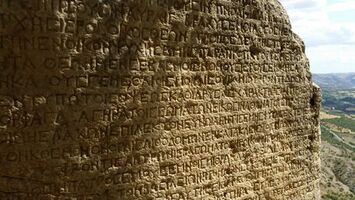The following post is by colleague Larry Hurtado. I agree with the conclusions of the article he is previewing, see my What’s in a Word? and The Living Word of God.
In researching for my current project (an analysis of NT papyrus P45 as an early Christian artefact), I’ve come across Charles Hill’s doughty case that the artefactual data reflects “the presence of a ‘canonical consciousness’ among Christian scribes from at least the late second century”: “A Four-Gospel Canon the Second Century? Artifact and Arti-fiction,” Early Christianity 4 (2013): 310-334.
The three claims that Hill sets out to challenge are these: (1) that extra-canonical gospels were as popular (or even more so) than the four that became canonical, at least till the early 3rd century; (2) that in the pre-Constantinian period we cannot distinguish NT manuscripts from “apocryphal” ones; and (3) that, therefore, categories such as “apocryphal” and “NT” or “canonical” and “non-canonical” are anachronistic, prejudicial and inappropriate for this early period.
In response, Hill first notes that the term “apocrypha/apocryphal” actually derives from a term used by the authors of certain writings, such as the “the secret [apocryphal] revelatory discourse which Jesus spoke to Judas” (Gospel of Judas), and several other such writings. That is, these texts quite openly affirm that they are “apocryphal” or secret, esoteric writings. There is no indication that they were composed to form part of some early Christian canon.
Then Hill counts the numbers of extant copies of various texts from the first three centuries. Granting that there are noteworthy variations among these texts (e.g., only one sure copy of GMark), he cites some 36 manuscripts of one or another of the four canonical Gospels, whereas he finds only 10 extant copies of other gospel writings.
Hill also notes the physical features of the copies of the various texts, citing the early Christian preference for the codex, especially for copies of texts used as scriptures. It is noteworthy that a number of copies of non-canonical texts (“apocryphal” and others) are bookrolls (scrolls), which suggests that these texts weren’t regarded as scripture. There is no copy of any of the canonical Gospels in a bookroll format (noting, however, the one copy of GJohn on a re-used roll).
And when we look at other physical features, such as codex size, use of “nomina sacra,” the nature of the handwriting, and use of “readers’ aids,” we also seem some interesting distinctions. For example, some of our copies of apocryphal writings are miniatures, private copies not intended to be read in corporate settings.
As a final feature, Hill cites the curious use of marks that he calls “diplae sacrae.” These are arrow-shaped marks in the margins of some manuscripts (>>) that seem to flag quotations of other texts cited as scripture. Hill cites examples of pre-Constantinian manuscripts that use these marks, and it is interesting that we have examples of citations of NT texts that are marked this way, suggesting that the copyist regarded the NT text as scripture.
For those seriously interested in the question, I heartily recommend Hill’s data-rich and tightly argued article.













